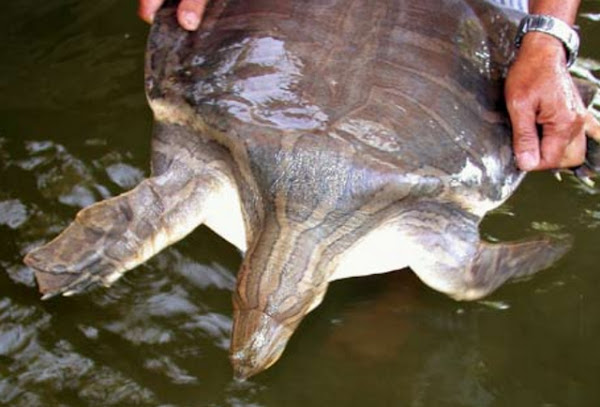Chitra vandijki (Burmese Narrow-Headed Softshell)
The common name of this Softshelled Turtle in English is commonly called Turtle Burmese Narrow-Headed Softshell Turtle, Myanmar Narrow-headed Softshell Turtle and Thai name called ตะพาบม่านลายพม่า (Dta-paap Maan Laai Burma)
ตะพาบม่านลายพม่า : Chitra vandijki Mccord & Pritchard, 2003
Chitra vandijki is a species of the Narrow-headed Softshell Turtle Genus (Chitra) within the Softshell Turtle Family (Trionychidae), Superfamily Trionychoidea, in the Suborder Cryptodira, in the Turtles Order (Testudines), in the Reptile Class (Reptilia), in the Chordate Phylum (Chordata) in the Animal Kingdom (Animalia).
Published in Mccord, W. P., O. S. G. Pauwels, R. Bour, F. Chérot, J. B. Iverson, P. C. H. Pritchard, K. Thirakhupt, W. Kitimasak and T. Bundhitwongrut. Chitra burmanica sensu Jaruthanin, 2002 (Testudines: Trionychidae): An unavailable name. Hamadryad 27 (2):214-216. (2003).
The specific epithet 'vandijki' honour of Peter Paul van Dijk, Dutch zoologist.
Geographic Range
Chitra vandijki is endemic to Myanmar and confirmed records are available for the Ayeyarwady and Chindwin Rivers, and their tributaries (Platt et al. 2014), with more recent records from the Salween River and the Sittaung River (K. Platt pers. comm. 2018). It occurs below 300 m asl.
Habitat and Ecology
Chitra vandijki is almost wholly aquatic and inhabits medium to large lowland rivers with sandbanks suitable for nesting (Platt et al. 2014). Little is known about the ecology of C. vandijki, but it’s congeners reportedly eat fish, molluscs, crabs and shrimp.
In captivity they have been observed ambushing fish from a concealed position under sand (Pritchard 2001). Over 70 eggs have been found in a nest (K. Platt pers. comm. 2018).
Age at sexual maturity is approximately 10–15 years based on the maturity of other Chitra spp. and 30–45 years is estimated as a generation length. Longevity is unknown, but presumed to be long and could be over 100 years.
Type locality: Khayansat Kone Village, Ayeyarwady River system, NE Myanmar.
Chitra vandijki is harvested for both domestic and international (East Asian) food markets.
Diagnosis
- overall color: chocolate brown;
- moderately complex midline (vertebral) carapacial pattern;
- midline (vertebral) carapacial stripe absent;
- simple radiating costal stripes;
- paramedian neck stripes forming a bell-like pattern on anterior carapace absent;
- neck stripes do not form a continuous light rim around carapace;
- distinct pair of neck stripes present;
- no dark speckling on “light” (head and neck) stripes;
- anterior neck “V” divergence point on neck;
- 3-4 forelimb lamellae;
- no peri-orbital X pattern;
- distinct peri-orbital ocelli present;
- no (or partial) distinct naso-orbital triangular “figure”;
- black dots present on chin pattern.
Synonym
- Chitra Indica William Theobald (1876)
- Gymnopus lineatus William Theobald (1876)
- Gymnopus indicus George Albert Boulenger (1889)
- Pelochelys cantorii George Albert Boulenger (1889)
- Pelochelys cumingii George Albert Boulenger (1889)
- Pelochelys bibronii George Albert Boulenger (1889)
- Trionyx indicus George Albert Boulenger (1889)
- Trionyx aegyptiacus var. indicus George Albert Boulenger (1889)
- Trionyx aegyptianus var. indicus George Albert Boulenger (1890)
- Trionyx (Gymnopus) bibroni Clifford Hillhouse Pope (1935)
- Pelochelys poljakowii Clifford Hillhouse Pope (1935)
- Trionyx indica Edward Harrison Taylor (1970)
- Trionyx aegyptiacus var. indica Edward Harrison Taylor (1970)
- Chitra burmanica Kittipong Jaruthanin (2002)
- Chitra burmanica Jarthanin (2002)
- Chitra vandijki William Patrick McCord & Peter Charles Howard Pritchard (2003)
- Chitra vandijki Gerald Kuchling et al. (2004)
- Chitra vandijki Tanya Chan-Ard et al. (2015)
- Platt, S.G., Platt, K., Win Ko Ko, and Rainwater, T.R. 2014. Chitra vandijki McCord and Pritchard 2003 – Burmese NarrowHeaded Softshell Turtle. In: Rhodin, A.G.J., Pritchard, P.C.H., van Dijk, P.P., Saumure, R.A., Buhlmann, K.A., Iverson, J.B., and Mittermeier, R.A. (Eds.). Conservation Biology of Freshwater Turtles and Tortoises: A Compilation Project of the IUCN/SSC Tortoise and Freshwater Turtle Specialist Group. Chelonian Research Monographs No. 5, pp. 074.1–7, doi:10.3854/crm.5.074.vandijki.v1.2014, http://www.iucn-tftsg.org/cbftt/..
- The Catalogue of Life.
- The Reptile Database.
- IUCN Red List of Threatened Species.
- Thai National Parks.
